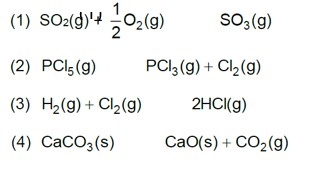7.14. One mole of H2O and one mole of CO are taken in a 10 litre vessel and heated to 725 K, at equilibrium point 40 percent of water (by mass) reacts with carbon monoxide according to equation.
H2O (g) + CO (g) ? H2 (g) + CO2 (g)
Calculate the equilibrium constant for the reaction.
7.14. One mole of H2O and one mole of CO are taken in a 10 litre vessel and heated to 725 K, at equilibrium point 40 percent of water (by mass) reacts with carbon monoxide according to equation.
H2O (g) + CO (g) ? H2 (g) + CO2 (g)
Calculate the equilibrium constant for the reaction.
-
1 Answer
-
Number of moles of water originally present = 1 mol
Percentage of water reacted= 40%
Number of moles of water reacted= 1 x 40/100 = 0.4 mol
Number of moles of water left= (1 – 0.4) = 0.6 moleAccording to the equation, 0.4 mole of water will react with 0.4 mole of carbon monoxide to form 0.4 mole of hydrogen and 0.4 mole of carbon dioxide.
Thus, the molar conc., per litre of the reactants and products before the reaction and at the equilibrium point are as follows:H2O
CO
H2
CO2
Initial moles / litre
1/10
1/10
0
0
At Equilibrium
(1 – 0.4) / 10 = 0.6/10
(1 – 0.4) / 10 = 0.6/10
0.4/10
0.4/10
Equilibrium constant, Kc= [H2] [CO2] / [H2O] [CO]
= [ (0.4/10) x (0.4/10)] / [ (0.6/10) x (0.6/10)]
= 0.16 / 0.36 = 0.44
Similar Questions for you
0.01 M NaOH,
M = 1 * 10-2

pOH = 2
pH = 2
Kp = Kc (RT)Dng
36 * 10–2 = Kc (0.0821 * 300)–1
Kc = 0.36 * 0.0821 * 300 = 8.86 » 9
A(g) ->B(g) + (g)
Initial moles n 0 0
Eqb. moles n(1 – a) na
total moles =
Eqb. pressure
On increasing pressure, equilibrium moves in that direction where number of gaseous moles decreases.
Taking an Exam? Selecting a College?
Get authentic answers from experts, students and alumni that you won't find anywhere else
Sign Up on ShikshaOn Shiksha, get access to
- 65k Colleges
- 1.2k Exams
- 679k Reviews
- 1800k Answers


